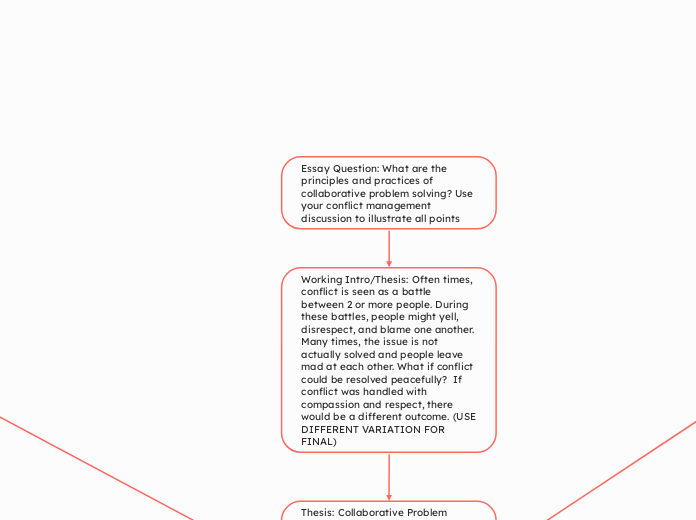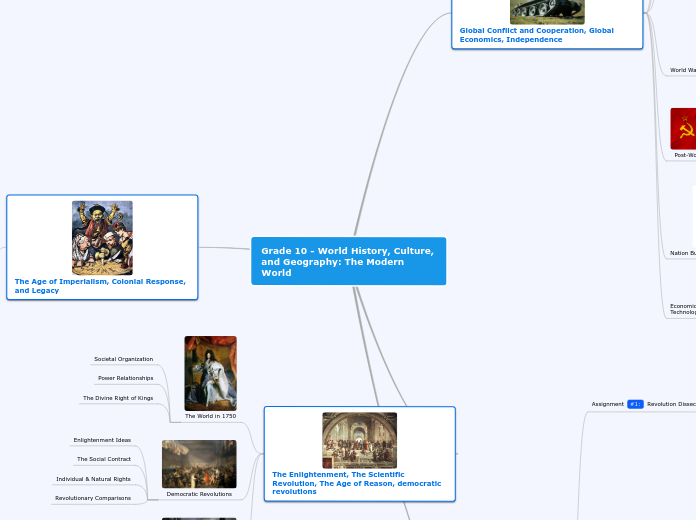Essay Question: What are the principles and practices of collaborative problem solving? Use your conflict management discussion to illustrate all points
Working Intro/Thesis: Often times, conflict is seen as a battle between 2 or more people. During these battles, people might yell, disrespect, and blame one another. Many times, the issue is not actually solved and people leave mad at each other. What if conflict could be resolved peacefully? If conflict was handled with compassion and respect, there would be a different outcome. (USE DIFFERENT VARIATION FOR FINAL)
Thesis: Collaborative Problem Solving is a conflict resolution process that promotes working with the other person to overcome conflict. Solving problems collaboratively requires parties to be vulnerable and identify unmet needs before finding solutions. To do this, there are four steps include, 1.) Connecting with the humanity of the other 2) Identify the needs of both parties 3) Brainstorming 4) Mutually Construct a Solution for Maximal Gain. Within these steps there are certain principles that serve as the foundation for the set of practices within each step. (USE DIFFERENT VARIATION FOR THE FINAL)
Step 4: Pick a Solution that Achieves Maximal Gain for both Parties.
What are the practices of seeking maximum gain?
1. Draw on the possibilities & evaluate your options.
Choose the best solutions
Weighed pros and cons for top 3 & identified how many needs met.
2. Identify solutions for maximal gain
and choose the solution for maximal gain
What are the principles of seeking maximum gain?
Develop a win win solution, Brainstorm, List, list, list, and list some more, Deviate from the norm
Embrace Messiness, and “Play off” each other
0 Sum game: Win/Lose
-Football game
-Fixed pie
Maximum Gain:
-Going beyond the fixed pie.
-Picking a solution that meets MAXIMUM needs for each person.
Step 3: Brainstorm
Applications from conflict conversation
My father and I found it fun and easy to play off each other and spitball ideas. A common thing that I heard my dad saying during our listing was "I don't care if you think your ideas are bad, I'm just spitballing here. Any idea is a good idea". We were able to come up with at least six ideas that we were happy with and came up with a win/win solution.
what are the practices of brainstorming?
Brainstorming creates diverse ideas about how to solve the problem.
List, list, and list; then list some more. Deviate from the norm when making solutions. Embrace messiness. “Play off” each other. Once all parties are working together, partners generate as many possible ways to meet each others needs. Avoid judgment even if the solutions are the worst thing you have ever heard.
Don’t worry about whether or not your ideas are bad or not.
List a lot
List options that may not meet everyone’s needs
Brainstorming is messy
Work together to exchange ideas with one another.
One side influences the other and creates a chain
Identify solutions for maximum gain
What are the principles of brainstorming?
The principles of brainstorming includes working collaboratively with the other person and generating solutions on the basis of needs.
Generating solutions on the basis of needs.
Coming up and listing solutions that work best for everyone involved in conflict
Working collaboratively with the other.
Both sides expression their sides of the story, needs, and positions in conflict. Expressing Compassion, Credulity, Curiosity, and Calmness are the four foundations to working collaboratively.
Step 2: Identify the Needs Of Both Parties
Application from conflict conversation
I expressed to my father that I needed the car to get to my job so that I can earn money and be able to pay for textbooks in the fall.
My father expressed to me that he needs his car to get to work, earn money, provide for his family, pay bills and taxes, and he needs to know where his car is at all times because the car is his property.
What are the practices of identifying needs of both parties?
The Practices include two types of conversing styles: Empathetic Listening mode and Self-Assertion Mode
Define: Self-Assertion Mode
Self-Assertion Mode includes the use of I-statements
Example of I-Statements: "When X happens, I feel X because I have a need for X". Don’t characterize and judge
Don't Characterize, judge, etc.
Being confident enough to voice your thoughts with confidence and ask for things that you feel you are deserving of is known as self-assertion.
Example: "When you talk, I can't hear the movie. Please keep it down."
An I-statement is a conversation that is expressed in conflictso that the recipient can hear it and give it their whole attention while feeling little to no defensiveness.
Example: “I feel worried when I don't hear from you, and I just want to know that you're ok and safe.”
Empathetic Listening Mode
Empathetic Listening involves
Asking questions about partners needs. Don’t interrupt when the other party is speaking. Listen and summarize your partners position and need in the conflict. Allow your partner to correct you. Express empathy for your partner’s plight/pain
Ask questions about partners needs
Don’t interrupt
Listen and summarize
Allow your partner to correct you
Express empathy for your partner’s plight/pain
The underlying principle for identifying the needs of both parties is to distinguish the difference between position and needs.
Needs: Underlying interests, desires, wants, unmet needs, fears.
One person wants to move for a job opportunity, the other wants to stay near family. The need/want would be that one person wants to move but the other person wants to stay where they are.
positions: Solution to an unidentified problem.
Provide Examples: Positions are taking a stance with your side of the argument.
Step 1: Connecting to the humanity of the other
Application from Conflict Conversation
The partner in my conflict was my father. Naturally, it is easy for us to connect with one another and see each other as human beings in conflict because we are family. But we also had similar if not the exact needs and positions that helped us connect and create compassion.
We had the same needs and positions on our conflict which made it easier to start problem solving.
What are the practices of connecting to the humanity of the other?
Putting our own beliefs aside for the time being to understand what the other party is experiencing.
Understanding the different positions/needs creates compassion, we see ourselves in the other, which is shared humanity.
To see the humanity in the other, you must be empathetic. Putting yourself in their shoes will help to manage conflict collaboratively.
Example: 1.) Make mutual dignity a precondition for engaging in a problem-solving discussion.
2.) Don't try to solve problems in anger
3.) Monitor your partner's feelings as well as your own.
What are the principles of connecting to the humanity of the other?
The 3 most important principles of connecting to the humanity of the other are preserving dignity, compassion, and credulity.
Credulity: When we are in conflict, It is not enough to just listen to what they are saying. But to be open to what they are saying and try and learn something from their experience.
Example: Taking a credulous approach to conflict is that no matter how much the other person doesn't make sense, what the other party is saying makes sense to them.
Compassion: In conflict, people often see each other was obstacles or opponents instead of human beings. This is where compassion comes in, when you extend compassion to your partner they bring down their defensive shield and return that compassion back to you.
Example: When Mascolo got out of his car to confront the older gentleman, he didn't see him as an opponent. Mascolo saw him as a human being who was looking forward to having a nice stress free weekend with his family.
Preserving Dignity: As stated by Mascolo (2020), dignity is the state of being worthy of value, honor, worthy, esteem, or respect. Preserving Dignity is important because people want to feel like they matter, not just to themselves, but in the eyes of others. Most Conflicts goes wrong when partners feel disrespected, undermined, insulted, etc...so this is important to knowledge/maintain the dignity of all parties involved.
Showing compassion and understanding to one party while the other remains adversarial.
Example: Mascolo had witnessed a young teenager rear end an older man on his way to vacation. The older man was furious at the boy and yelled at him for ruining his vacation. Mascolo got out of his car and treated the man with respect, which in turn got the man to calm down.









